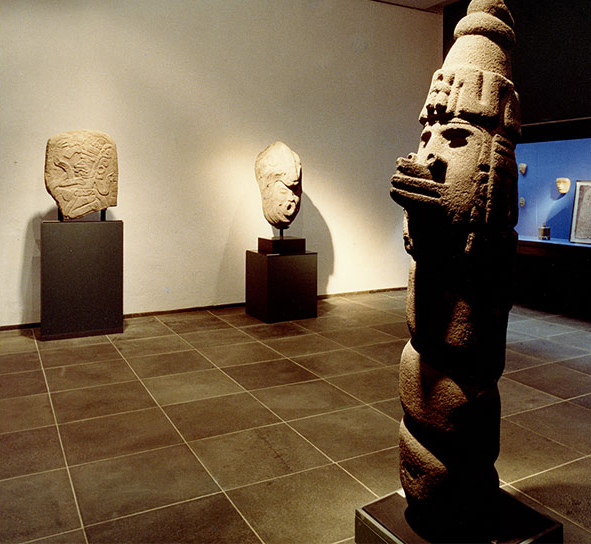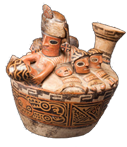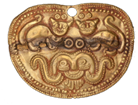



The Collection
Pre-Columbian art – including objects of the Mayas and Incas – was among the early passions of Irene and Peter Ludwig. The collectors from the city of Aachen included the cultures of pre-Columbian America into their concept of world culture as a matter of course. Their passion was extremely fortunate for the Rautenstrauch-Joest Museum as it received the pre-Columbian collection of the Ludwigs, which they had acquired in the international art-trade, as an (initially) permanent loan in the early 1960s. In 1983 this loan was donated to the City of Cologne, and in 2003, at the request of the late Irene Ludwig, it was permanently integrated into the collection of the Rautenstrauch-Joest Museum.
The Ludwigs collected about 200 objects from the diversity of preserved material evidence of the pre-Colombian cultures. These artefacts are mainly made from stone, clay and gold and are now presented to the public for the first time since 1985.
One third of the exhibits are from Mesoamerica; two thirds from South America.
Exhibition
The title of the exhibition “The Divine Heart of Things - Pre-Columbian Art from the Ludwig Collection” points out two important characteristics of the presented objects: on the one hand they were collected by Peter and Irene Ludwig as works of art. On the other hand most of these works were ritual objects in their original cultures or located in a religious context, e.g., as grave goods.
Using 16 thematic areas which illustrate the function of the artefacts for the communication between humans and the supernatural or divine, this exhibition takes an in-depth look at the history and “the divine heart” of the exhibits. The exhibition covers the period from 1200 BC to 1550 AD, but also shows how topical pre-Columbian art for many people in Latin America and Europe still is.
In the entrance area, one of the highlights of the collection welcomes the visitors: the 2-metre (6 feet) tall sculpture of the Aztec wind-god Ehecatl. The next room is devoted to the chequered history of the collection, one of its aspects being the topic of forgeries of pre-Columbian art. The given tour presents the two Americas in the shape of two intersecting “ovals” and makes it possible to juxtapose the Mesoamerican objects with the South American works and thus highlight their interrelationship. The points of contact are highlighted by a cross-thematic tour of a selection of culturally comparative themes such as the importance of “strong” animals such as jaguars in rituals and religion, precious materials such as gold and jade, and specific healing methods. Special facet points present the individual objects and object groups from different perspectives.

Mesoamerica
A third of the objects of the Ludwig Collection are from Mesoamerica – a cultural area extending from north Mexico to El Salvador. At the latest from 1800 BC, this region was home to various cultures. They all shared certain common features: growing maize as a staple food, playing the ball game, valuing jade and using a written calendar.
The majority of the Ludwig Collection objects date from Mesoamerica's Classic Period (250–900). They offer an insight into the sphere of influence of post-Olmec Gulf Coast cultures and into the Maya culture in southern Mexico and Guatemala. Central Mexico and the regions of Puebla and Oaxaca are represented by some exhibits of Teotihuacán, Aztec and Mixtec provenance.
The inner ring of the exhibition is devoted to Mesoamerican cultures. The theme of the ball game, for instance, widespread in all these cultures, is presented by reference to heavy ceremonial objects in stone and a video sequence of modern-day ball players. The multi-facetted Maya culture, whose rulers regarded themselves as mediators of the gods, contributes the largest group of objects with roughly 20 exhibits.





Crocodile head sculpture (water spout)
Unknown provenance, reportedly San Lorenzo, Veracruz, Mexico; Olmec, early Pre-Classic, 1200–900 BC; Basalt; length 69 cm; Photo: Wolfgang F. Meier, © Rheinisches Bildarchiv / Rautenstrauch-Joest-Museum





Hacha (axe-shaped ballgame-equipment)
Unknown provenance, probably Veracruz, Mexico;
Gulf Coast culture, late Classic, 600–950
Dolerite, height 16 cm
Photo: Wolfgang F. Meier, © Rheinisches Bildarchiv / Rautenstrauch-Joest-Museum





Incense burner stand
Unknown provenance, reportedly Palenque region, Chiapas, Mexico; Maya, Late Classic, late 7th century
Clay, traces of colour; height 77 cm
Photo: Wolfgang F. Meier, © Rheinisches Bildarchiv / Rautenstrauch-Joest-Museum





Cihuateotl figurine
Unknown provenance, reportedly Veracruz, Mexico; Gulf Coast culture, late Classic, 700–900
Clay, traces of colour; height 91 cm
Photo: Wolfgang F. Meier, © Rheinisches Bildarchiv / Rautenstrauch-Joest-Museum





Façade sculpture
Unknown provenance, reportedly east of the Templo Mayor district, Mexico City, Mexico;
Aztec, around 1507;
Andesite, traces of colour;
Photo: Wolfgang F. Meier, © Rheinisches Bildarchiv / Rautenstrauch-Joest-Museum





South America
Around two-thirds of the Ludwig Collection objects are from the area of present-day Peru. From around 3500 BC, agriculture and livestock farming in the Andes highlands as well as intensive exploitation of marine resources on the coast forged the economic basis for later constructing monumental cult centres.
The so-called Early and Late Intermediate Periods mark temporary phases when different localised regional styles emerged. The collection primarily includes examples of the Nasca, Recuay, Vicús and Moche in the Early Intermediate period (200 BC / 100AD–AD 650/800) and Sicán, Chimú and Ica-Chincha in the Late Intermediate period (1000–1476).
The outer “South American” tour of the exhibition shows a rich palette of the most colourful aspects of ancient Peruvian art: naturalistic ritual ceramic vessels with erotic scenes and numerous gold artefacts, ranging from minuscule, filigree faces to wafer-thin gold feathers, over 30 cm (c. 12 inches) in length, which once embellished the crowns of high-ranking persons with “divine splendour”.





Crown of a ruler or high-ranking government official
Unknown provenance, Peru;
Late Intermediate, Chimú style, 1000–1470;
Gold-silver-copper alloy; height 18,4 cm
Photo: Wolfgang F. Meier, © Rheinisches Bildarchiv / Rautenstrauch-Joest-Museum





Vessel with erotic scene
Probably upper Santa valley, Peru;
Early Intermediate, Recuay style, 300–600;
Kaolin; height 21 cm
Photo: Wolfgang F. Meier, © Rheinisches Bildarchiv / Rautenstrauch-Joest-Museum





Nose ornament with feline bodies and unknown mythical creature
Vicús, Peru; Early Intermediate, Vicús style, 200 BC–400 AD
Gold-silver-copper alloy; width 11,9 cm
Photo: Marion Mennicken, © Rheinisches Bildarchiv / Rautenstrauch-Joest-Museum





Beaker with night-sky deity
Lambayeque region, presumably Huaca El Corte, Batán Grande, Peru; Late Intermediate, middle Sicán style, 900–1100
Gold; height 21 cm
Photo: Marion Mennicken, © Rheinisches Bildarchiv / Rautenstrauch-Joest-Museum





Funerary shroud
Unknown provenance, probably Central Coast, Peru; Late Intermediate, Chancay style, 1000–1440
Cotton, camelid hair;
Plain weave, supplementary brocading wefts, Height 126 cm
Photo: Wolfgang F. Meier, © Rheinisches Bildarchiv / Rautenstrauch-Joest-Museum





Tours
Thursdays, 6 p.m. (Except for: 18.10.12 / 22.11.12 / 20.12.12 / 24.01.13 / 14.02.13)
and Sundays, 3 p.m. / Admission special exhibition
Short Topical Tours (30 minutes)
Tuesdays, 12.30 AM / Admission special exhibition
09.10.12 „Beseelte“ Objekte aus Meso- und Südamerika“
06.11.12 „Altperuanische Erotika: Fruchtbarkeit, Heilung und Tod“
04.12.12 „Die Maya: Politik und Ritual an der Weltenachse“
08.01.13 „Altperuanisches Gold: Göttlicher Glanz und der Kreislauf des Lebens“
05.02.13 „Das mesoamerikanische Ballspiel um Leben und Tod“
Tour by curator
with Anne Slenczka on following Sundays, 3 p.m.:
18.11.12
16.12.12
13.01.13 (tour in Spanish)
17.02.13
Events
18.10.12 – 7 p.m.
„Altperuanische Erotika: Kommunikation zwischen Menschen und Göttern“
Vortrag von Dr. Christiane Clados, Berlin / Forum VHS, 6 €, concessions 4 €
03.11.12 – from 7 p.m.
„Lange Nacht der Museen“: Rund um den Cumbia-Tanz / 16 €
18.11.12 – 10 AM until 6 p.m.
Thementag Südamerika / Eintritt Museum
22.11.12 – 7 p.m.
„…und schon wieder Weltuntergang: Der Mayakalender und die Prophezeiungen
für 2012“
Vortrag von Dr. Lars Frühsorge, Universität Hamburg / Forum VHS, 6 €, concessions 4 €
13.12.12 – 8 p.m.
Duo Julio Mendívil y Davíd Sandoval.
Konzert / Forum VHS, 12 €, concessions 8 €
17.01.12 – 7 p.m.
„Wie die Seele in die Dinge kommt: Die Rolle von Objekten im Ritual der Maya“
Vortrag von Prof. Dr. Nikolai Grube, Universität Bonn / Forum VHS, 6 €, concessions 4 €
21.02.13 – 7 p.m.
Spielfilm: „Und dann der Regen“. Film / Forum VHS, 6 €, concessions 4 €
Rautenstrauch-Joest Museum – Cultures of the World
Cäcilienstrasse 29-33
50667 Cologne, Germany
Tel.: 0221/ 221-31356
Fax: 0221/ 221-31333
E-Mail: rjm@stadt-koeln.de
Opening Hours
Tue - Sun 10 AM – 6 p.m., Thu 10 AM – 8 p.m.,
every first Thursday of the month opened until 10 p.m., closed on Mondays
Admission
Single ticket special exhibition 6 €, concessions 4 €
Combi-ticket special- and permanent exhibition 10 €, concessions 7 €
Transportation Connections:
Nearest stop: Neumarkt
KVB lines 1, 3, 4, 9, 16, 18
Bus lines 136, 146
Parking: Parking deck in the building, entrence over Cäcilienstraße
Imprint
The Divine Heart of Things – Pre-Columbian Art from the Ludwig Collection
An exhibition of the Rautenstrauch-Joest Museums – Cultures of the World
Kuratorin: Anne Slenczka
Projektleitung: Klaus Schneider
Texte: Anne Slenczka mit Jutta Engelhard, Burkhard Fenner, Clara Himmelheber, Brigitte Majlis auf Basis des Katalogs
Konservatorische Betreuung: Christian Andert, Robin Bastian, Birgit Depenbrock, Petra Czerwinske, Kristina Hopp, Stefanie Lüerßen
Presse und Öffentlichkeitsarbeit: Annabelle Springer
Bild Redaktion: Tabea Schiefer, Anne Slenczka
Ausstellungsarchitektur und -grafik: res d, Köln
Werbemittel: res d, Köln
Übersetzung ins Englische: Andrew Boreham
Fachtermini Englisch: Christiane Clados, Annette Kern
Lektorat Englisch: Sarah Fründt, Hanin M. Habig, Clara Himmelheber
Begleitheft Englisch: Hanin M. Habig, Lea Stöver
Praktikantinnen: Hanin M. Habig, Lea Stöver, Anna Marckus, Sophia-Maria Meier, Justine Tutmann
Beleuchtung: Gerhard Graef
Grafikproduktion: Oschatz Visuelle Medien GmbH & Co. KG, Wiesbaden
Maler: A. + M. Höveler GmbH, Brühl
Ausstellungsbau: Blank GmbH, Düsseldorf
Webseite/ Programmierung: Redaktionsbuero Dank, Köln
Ein besonderer Dank gilt den Autorinnen der Katalogtexte: Christiane Clados, Stefanie Teufel mit Beiträgen von: María Teresa Cervantes de Braginski, Andrea Ruf, Anne Slenczka
The Rautenstrauch-Joest Museum gives thanks for further support
Walter Alva, Museo Tumbas Reales de Sipán, Peru; Beier, Freund und Kühler, Köln; Bibliothek des Ibero-Amerikanischen Instituts, Berlin; Alexander Brust, Museum der Kulturen, Basel; Gertrud Borsch; Birgit Brand; Christian Breuer; Otto Danwerth; Christopher B. Donnan; Ehrenamtlerteam des RJM; Ralf Eidneier; Conny Eisfeld, Königsfurt-Urania Verlag; Monika Feinen; Miguel Ferraz und Friederike Rörhup; Foundation for the Advancement of Mesoamerican Studies; Rüdiger Fresemann; Lars Frühsorge; Gereon Goldbach; Nicole Golombek; Peggy Gough, University of Texas Press; Nikolai Grube; Antje Gunsenheimer; Beate Haasbach-Gupta, Queen Games; Christian Heck; Heike Hermann; Markus Hertzsch; Waltraud Herz; Marie-Luise Höfling; Lukas Hofmann; Ulla Holmquist, Museo Larco, Peru; Iris Kaebelmann; Barbara und Justin Kerr; Felix Knetsch, Fa. Sirius, Wesseling; Ralf Kotalla; Katharina Krebs; Zara M. Krpata; Sara Ladrón de Guevara; Thomas Lehmkuhl; Mimi Muray Levitt; Mariusz Lewicki; Manfred Littfin; Oliver Lueb; Kathleen McCampbell; Don & Donna McClelland; Wolfgang F. Meier; Elisa Mencos, Museo Popol Vuh, Guatemala; Julio Mendívil; Marion Mennicken; Peter Mesenhöller; Ursula Metz; Museo Nacional de Antropología, Arqueología, e Historia, Peru; Ulrike Nestler; Karoline Noack; Rolf Oeser; Boas Paz; John Powell, The Newberry Library, Chicago; Walter Queins; Redaktionsbüro Dank; Roberto Rochín; Georg Ropohl; Frauke Sandig und Eric Black; Gaby Sawer; Andreas Schön; Izumi Shimada; Eric Slack; Viktoria Sondermann; Michael Tellenbach; Team der WIS RJM; Carl Triesch; Elisabeth Wagner; Maryam Yadegari; Mario Zankl

